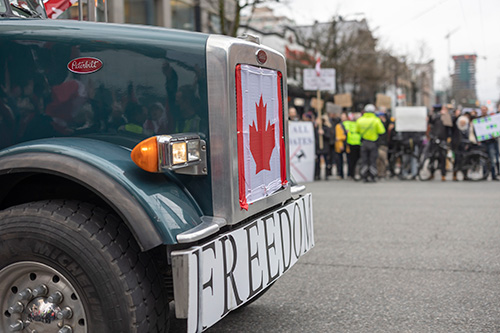Whether it’s a vigil for missing and murdered Indigenous women or a march for climate justice, chances are you’ve seen an article about a protest in recent years.
In a society marked by increasing violence and polarization, how do non-violent actions such as protests help change society? How do they change participants?
Anna Vogt is an expert on the theory and practice of non-violent direct action. Vogt is director of advocacy and policy for Mennonite Central Committee (MCC) Canada. She is based in Ottawa, where she and her team lobby for a more peaceful and just world.
Vogt has been interested in non-violent action since university, where she researched the topic in the work of Martin Luther King, Jr. and Gandhi. But it was in her time in Colombia with MCC’s Seed program that allowed her to “experience the messy reality” of protest.
From 2011-13, Vogt lived and worked in Mampuján, Colombia, with an Afro-Colombian community that was part of the nearly 7 million people displaced inside Colombia by decades of armed conflict.
A landmark court case in 2010 declared that the people were entitled to financial compensation from the government for their individual and collective losses.
By 2011, there was no sign of the compensation. So, they decided to walk.
Vogt was invited to join the 600 community members as they walked 70 kilometres from their village to the city of Cartagena to meet with government officials. She describes the invitation to walk with them as “deeply humbling.”
“We did it,” Vogt recalls. “We marched for two days. We held signs, and we walked for the rights of all victims.”
In the end, the walk was instrumental in ensuring the court decision was upheld.
What was just as powerful for Vogt was the transformation she witnessed in the villagers who participated in the journey.
“Victims aren’t just victims,” she says. “They’re people with dignity. Some of the people who walked wore fancy shoes or their best clothes. There was this sense of agency in choosing to walk. It felt like the day they were displaced, they said, but this time they were choosing it.”
Vogt’s experience in Colombia has shaped her views on non-violent direct action in Canada.

In 2020, the Freedom Convoy set up camp in Ottawa, just a few blocks from Vogt’s apartment. She walked to the protest to chat with people and to hear their stories.
The diversity of experience and opinions she found there stood in deep contrast to the stories being told on news sites across the country.
“It’s easy to take a few talking points and to paint everyone with the same brush,” she says, warning of the harm that can come from telling simple stories.
For those who feel that non-violent direct action doesn’t go far enough, and for those who feel it goes too far, Vogt offers three considerations:
1. Studies on non-violent direct action in the past 20 years have shown that these actions are better than violence at creating sustainable change.
2. The physicality of non-violent direct action, such as marching or singing, helps change the tenor of conflict. It’s much harder to hate someone with whom you’re walking or sharing a meal. Move your body and engage your senses.
3. There’s almost always common ground. Find it.
“If our starting point is a protest … how does our strategy include unlikely allies? How am I testing those assumptions? How do we build these muscles?” Vogt asks. “Even when we disagree with someone, you want things to be better. I want things to be better. How do we acknowledge that well?”





Comments
Speaking as a non-expert in the theory and practice of direct action, I am curious how Vogt would define 'direct action'. I understand it as something which specifically enacts a change, rather than calling for that change - directly enacting the desired outcome.
Direct action examples include disrupting weapons manufacture and shipping, interrupting or blocking pipeline or military construction, separating individuals who are fighting, creating safe consumption sites, organizing boycotts and conscientious objection. Direct action is likely a protest, and also a demonstration, but most protests and demonstrations are not direct action, because they are address a government and the general public to register a complaint, express an opinion, and attempt to show support for a particular cause.
All these examples are also more or less symbolic, more or less public, and more or less effective in accomplishing actual change - not to mention they are more or less non-violent, either in their intention or the way they are perceived: 'the messy reality of protest'.
The description of the Mampuján community walk is described as direct action, and it was clearly very empowering for the participants, and it had something to do with a positive outcome, but it's not clear how the walk led to the implementation of the decision (of course, many factors must have been involved). Likewise, the Freedom Convoy in Ottawa is well known to have had a significant impact on the community hosting it, but the participants were already practising direct action by refusing to enact or accede to vaccine mandates, and it looked to me like an extensive act of protest rather than direct action.
Interesting to consider each of these! Thank you for the prompt for thought.
Add new comment
Canadian Mennonite invites comments and encourages constructive discussion about our content. Actual full names (first and last) are required. Comments are moderated and may be edited. They will not appear online until approved and will be posted during business hours. Some comments may be reproduced in print.